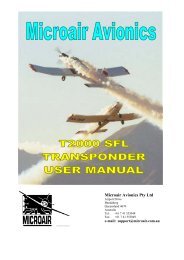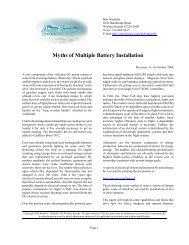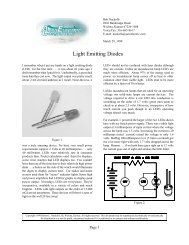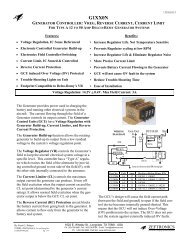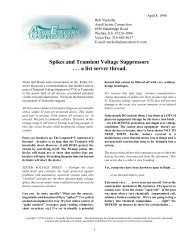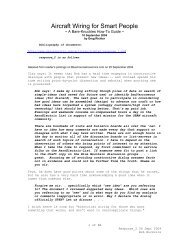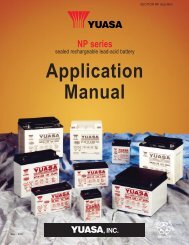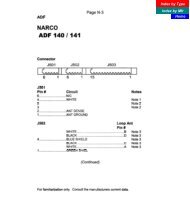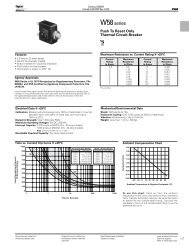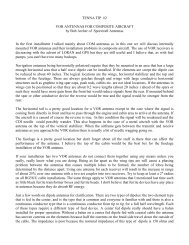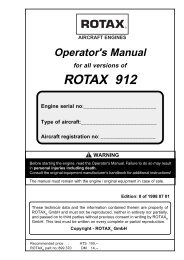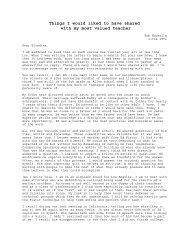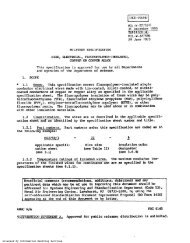Brushes for Aircraft Applications - AeroElectric Connection
Brushes for Aircraft Applications - AeroElectric Connection
Brushes for Aircraft Applications - AeroElectric Connection
You also want an ePaper? Increase the reach of your titles
YUMPU automatically turns print PDFs into web optimized ePapers that Google loves.
<strong>Brushes</strong> <strong>for</strong> <strong>Aircraft</strong> <strong>Applications</strong>Bob Nuckolls<strong>AeroElectric</strong> <strong>Connection</strong>April 1993Updated August 2003Several times a year I receive a call or letter asking where oneobtains "aircraft" grade brushes <strong>for</strong> an alternator or generator.One of my readers called recently to say he had been verballykeel-hauled by an engineer with an alternator manufacturingcompany. The reader had confessed to considering a plainvanilla brush <strong>for</strong> use in the alternator on his RV-4.There's a lot of "hangar mythology" about what constitutesaircraft ratings in components. We all know that much of whatis deemed "aircraft" today are the same products certified ontoairplanes 30-50 years ago. Many developers and suppliersconsider aviation a "dying" market; few are interested inresearching and qualifying new products. However,automotive markets continue to advance in every technology.It is sad to note that many products found on cars today farexceed the capabilities and quality of similar hardware foundon certified airplanes. Alternators, motors and componentsthereof are striking examples!First, know that brushes <strong>for</strong> aircraft generators, motors andalternators come in many grades which are neither "aircraft"nor “alternator” in makeup, just different grades. When "highaltitude” operations are anticipated (where moisture in the airis lacking) a brush rated <strong>for</strong> altitude may indeed be advisable.Know also that "high altitude” usually means 25,000 feet andUP! When a product requiring brushes is designed, it will betested <strong>for</strong> adequate per<strong>for</strong>mance, first in the lab and then in aworking environment. Real-world testing ultimately ensureswhether a given brush is suited to a task.It’s not uncommon to discover that a brush grade whichworked well in one application may not per<strong>for</strong>m as well in asimilar application. <strong>Brushes</strong> are subject to many stresseswhich include but are not limited to: velocity of conductorsurface under the brush, current, magnetic characteristics ofthe machine, spring pressure, altitude, humidity, vibration,duty cycle, etc.To automatically assume that brushes <strong>for</strong> aircraft productsshould also be rated <strong>for</strong> high altitude ignores design andtesting ef<strong>for</strong>ts done when the product was certified.Often, brush requirements are imposed arbitrarily to the extentthat they are grossly unreasonable. For example, in about1980, an AD was placed against all 20-series Learjets <strong>for</strong> poortrim speed control. I was working on a new, electronicallyregulated trim system <strong>for</strong> Model 55 Lears. I was confident wecould develop an expedient fix <strong>for</strong> the older airplanes. Theprogram went well until we began testing <strong>for</strong> a requirement byLear that brush life on the primary and secondary trim motorsbe 1000 hours or more of continuous motor operation! Wewere hard pressed to demonstrate more than 600 hours fromany grade of brush. This little motor runs at 22,000 rpm! Therewere simply no brush products available that would last 1000hours at those commutator surface speeds.The program was nearly scuttled when project managersbecame fixated upon reaching the 1000-hour goal. Weresearched our service records <strong>for</strong> the same motor supplied inother <strong>for</strong>ms <strong>for</strong> over 10 years.Clutches and brakes turned out to be the #1 service problem.Brake problems occurred at 300 to 500 flight hours, not motoroperating hours. Given that trim operations might run a pitchtrim actuator perhaps 3 minutes total per flight cycle, 1000hours of flight on a Lear might put less than 50 hoursoperation on the trim motor. Not once did we receive a motorback <strong>for</strong> repairs because of worn brushes! <strong>Brushes</strong> wereautomatically replaced on every overhauled unit; the overhaulshop's scrap brush box was full of brushes ranging fromlike-new to very serviceable.In the real world, brushes were never a service issue. I can tellyou that the brush grade which ultimately per<strong>for</strong>med best inthat application was neither rated <strong>for</strong> "high altitude" norrecommended by its manufacturer <strong>for</strong> "aircraft" service. Thiswas in spite of the fact that trim motors in Lears are exposedto outside ambient conditions.Some folks are adamant in their beliefs about brush ratings.I’ll suggested that brushes are never properly applied byratings alone, testing in a service context is the only truequalification of a product. A brush is but one component of acomplex system. Experience in the field is a better judge ofcapability than all the analysis in the world.Most certified “aircraft” alternators are serviced <strong>for</strong> shorteddiodes and worn bearings, worn belts and drive couplings witha good sprinkling of broken attach brackets.Getting back to the "upset" engineer: without seeing his testand field experience data, I cannot judge the propriety of hisactions. It is entirely possible that some altitude rated brushper<strong>for</strong>med better <strong>for</strong> him in a low altitude aircraft applicationthan one which was not rated. Irrespective of the facts in thisone incident, understand that it is unwise to discuss andperhaps make decisions about components of an airplane (orany other machine) without having ALL the facts and datasurrounding its application in the flight SYSTEM. Worthless,
perhaps even bad decisions, can be made from "hangarengineering."For over 15 years, I’ve observed field service history onmodern automotive alternators fitted to amateur built aircraft.These have provided exemplary service with the same slipring brushes as supplied <strong>for</strong> ground vehicle duties. There hasnever been the slightest hint of a design or installationproblem with brushes, or <strong>for</strong> that mater, any other component.Should the topic of altitude rated brushes come up in yourtravels about the aviation community, know that there’s a longdemonstrated service history that shows this is simply not anissue.*****-----*****



![G-Series-Ext [pdf] - Carling Technologies](https://img.yumpu.com/50918301/1/190x245/g-series-ext-pdf-carling-technologies.jpg?quality=85)
